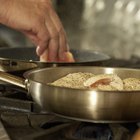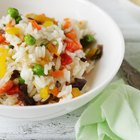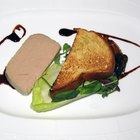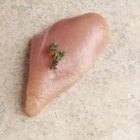
Baked or roast chicken with vegetables is a satisfying comfort food that lends itself to endless variations. Simply dress the chicken, and rest it on a bed of simply seasoned root vegetables or summer garden offerings. It is safe to cook chicken and vegetables together as long as you practice safe food handling throughout the preparation and baking processes.
Handling the Chicken
According to Food Safety News, Seattle microbiologists tested 100 raw chicken samples from area grocery stores, and found each of the pathogens Staphylococcus aureus and Campylobacter on half of the birds. Raw chicken can also contain salmonella, E. coli, and listeria. Although safe cooking temperatures kill these pathogens, raw chicken requires diligent attention to avoiding cross contamination. Bleach cutting boards, bowls and knives that have come into contact with raw chicken. Wash your hands after handling raw poultry, or wear food-service grade disposable gloves and discard them after you handle the bird.
Handling the Vegetables
Most recipes for chicken baked with vegetables instruct you to prep the vegetables first, and use them as a base for the cooking chicken. As the chicken heats and releases its juices, the flavor seeps into the vegetables. Handling raw vegetables usually poses no food safety risk, as long as you avoid using the same knives and cutting boards you used for the chicken.
Cooking the Chicken
Bake chicken until it reaches 165 degrees Fahrenheit. Use a metal stem thermometer to check the temperature in the thickest part of the bird, and check several different places because many ovens don't heat evenly. Once your chicken reaches a safe internal temperature, the juices that it releases onto the vegetables will also be safe. The vegetables will reach 165 F more quickly than the chicken, and this temperature kills any pathogens that may have come from the chicken before it was fully cooked.
Post-Cooking Food Safety
Once your chicken and vegetables are fully cooked, they still require safe handling. Keep the dish hot until you serve it, and avoid leaving it out for long afterwards. Keep the cooked dish away from any uncooked meat or poultry, as well as the surfaces you used to handle them.
Related Articles

Can I Cook a Whole Chicken Without ...

Can I Cook Chicken Two Weeks After the ...

Can I Cook a Chicken Five Days After ...

If Chicken Doesn't Smell Bad, Can You ...

Leaving Cooked Vegetables Unrefrigerated

What Are the Dangers of Cooking With ...

Do You Have to Wash Your Hands When You ...

How Long Is Cooked Chicken Good?

What Happens if You Cook Chicken With ...

Vegetable Rice Calories

Can I Stop Cooking a Chicken Halfway & ...

How Long Can I Keep Frozen Whole ...

If Chicken Smells Bad Can You Still ...

How to Roast Cornish Hens With Potatoes ...

How to Keep Thawed Liver Before Cooking ...

How to Make Crock-pot Chicken

How to Bake Boneless Chicken to Stay ...

How Long Can Chicken Stay Out Without ...

How Long Do You Need to Boil Large ...

Do You Need to Defrost Chicken Wings ...
References
Writer Bio
Devra Gartenstein is a self-taught professional cook who has authored two cookbooks: "The Accidental Vegan", and "Local Bounty: Seasonal Vegan Recipes". She founded Patty Pan Cooperative, Seattle's oldest farmers market concession, and teaches regular cooking classes.
Photo Credits
Stockbyte/Stockbyte/Getty Images